Text
Urban Iphoneography: Haunted Edition

#berlin, @berlinstagram
In this post, I'm featuring a series of photographs taken at a vacant themepark by iphoneography artist Michael Schulz. I loved the series of photographs that slowly appeared in my instagram feed from this artist taken while touring Spreepark in Berlin, the city he captures on his instagram account.
I've uploaded some of my favorites that he's posted. I wanted to see what they would like as a collection. Some capture abandonment, silence, and austerity through the use of reflection and stillness, capturing overgrowth and the effects of prolonged inactivity in nature versus manmade. I've always liked how the artist has a subtle nod to architecture in some of his photos. In addition, he adds a little humor, my favorite being the photo of the swan boats. To see his profile check out @berlinstagram.

To answer previous questions: Yes, this is the abandoned amusement park where the movie Hannah was filmed. No, you can't climb into the area because there's a lot of security. No, you can't go there spontaneously - you've to book a tour in advance - either a guided tour via www.berliner-spreepark.de or an "explore everything on your own and climb around wherever you want" (which i did) via www.go2know.de. #berlin, @berlinstagram
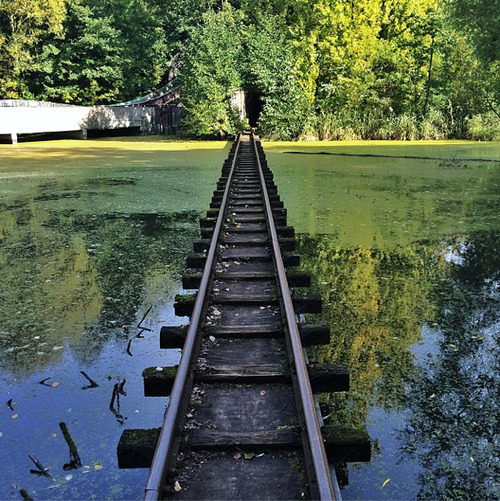
#berlin, @berlinstagram
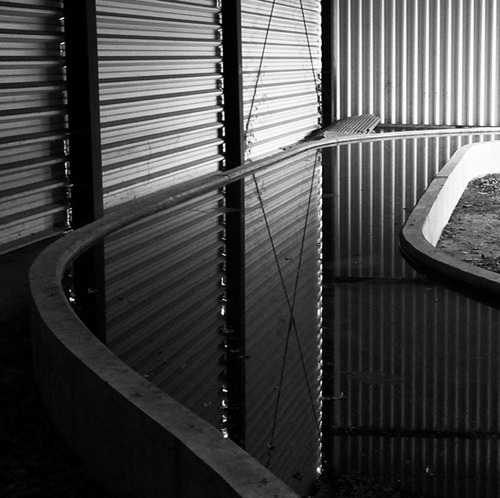
#berlin, @berlinstagram

@berlinstagram

#berlin, @berlinstagram
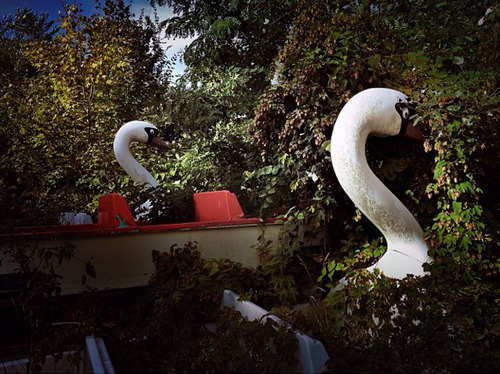
#berlin, @berlinstagram
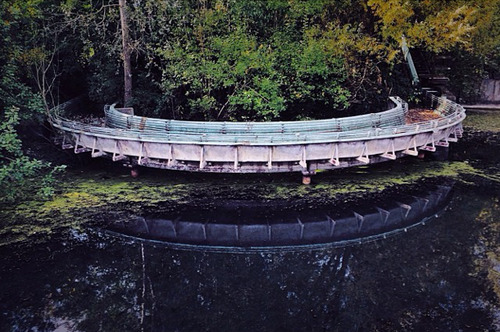
@berlinstagram
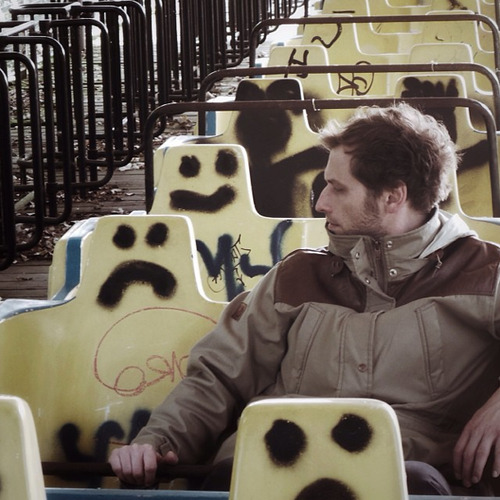
not everyone had fun! #spreepark #berlin, @berlinstagram
0 notes
Video
youtube
Trailer from Ben Kalina's film Shored Up
#ShoredUp#film#documentary#Jersey Shore#barrier islands#superstorm sandy#Long Beach Island#Stephen Colbert
0 notes
Text
"If the tide lasts more than 4 hours, call your climatologist." - Stephen Colbert
As a student of architectural design and a relief volunteer on disaster projects, I am drawn to the subject of rising sea level and how it affects infrastructure. I was intrigued particularly with how it affects the coastal region around me in both New York and New Jersey. From my volunteer work, in Japan after the tsunami and in Staten Island after the storm surge, combined with my academic research in design and infrastructure as it relates to rising sea levels, Ben Kalina’s film Shored Up shared many of my personal interests. It was worth buying a ticket the view the documentary as the research was presented very clearly, and at times comically, while really addressing the arguments of rising sea levels as it relates to our coastlines.
When I was abroad working along the coastlines of Northeastern Japan after the Great East Tsunami, the destruction of building infrastructure was devastating. This one shore town, Rikuzentakata in the Tohoku Prefecture, that sat straight along the coast, was completely flattened. From the previous tsunami decades prior, the town had built a higher seawall that was to be closed in the event of a wave as well as planted thousands of tall trees along the coastline as both a memorial to the previous tsunami as well as an ecological ‘seawall’ of sorts as preventative method. Following the tsunami the physical wall was not high enough to protect the small city from the tidal wave, and only one of those trees, of the thousands planted, stood. It stood lonesome among a bed of flattened homes, buildings, cars, boats, and memories.
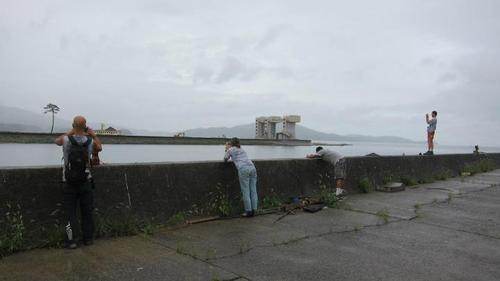
.Rikuzentakata. Lone pine tree. 4 months after tsunami.
The difference between the disaster of a tsunami and the disaster that struck us last October is that although the Japanese were not prepared for the size of the wave that came after the earthquake, they understand in their culture that these waves come and wipe out their coastal towns from time to time. It is something that has been repeated over and over in the past and has been documented. The tsunami, the wave, is all a part of their culture. They view water as both something beautiful and something evil.
Here on the the East Coast, no one was prepared for the devastation and destruction that ensued. Though it was a storm surge, and not a tidal wave, homes, businesses, etc. were demolished by salt water in the same way.
Where I have been volunteering in Staten Island, the week after Superstorm Sandy, we reviewed the damage. The houses closest to the water were flattened. The further down the street away from the beach there was foundation, then studs, then studs with vinyl siding attached, and finally a house with a roof. The cars had all been flooded and pushed down the streets, into homes, and on top of one another. By the second week the houses and cars had all been assessed by insurance companies, FEMA, etc. “This property is condemned” lined the front doors from one street to the next.
As a disaster relief volunteer, one of jobs entails getting homes ready for gutting. We gut up to the flood lines. And a lot of clearing and removal of debris takes place before gutting. One of the first lines in Kalina’s film, as stated by a resident of Long Beach Island, is “It’s your life on the curb.” She said this as the structure of her home was being cleared of debris and the contents were being placed on the curb for curb-side garage removal. Right off the bat at the beginning of the film, I felt that was one of the more compelling themes in the film, that this kind of destruction is one that is extremely personal and life-changing. The destruction that is a product of rising sea levels is a serious issue that will affect the lives of many. And I believe it to be a great moment to begin with in the film.
Not having great knowledge or vocabulary of geology or ecology of it all, the cinematography combined with the writing really created for a clear and entertaining description of the arguments at play. There were two story lines were the producer or cinematographer chose to have a volley between different individual’s opposing arguments creating for some comic relief in the film. Video from Stephen Colbert’s nightly program was even introduced in response to comments made by North Carolina’s state legislature’s approach to rising sea levels and their coastlines which was a really special part of the film that I enjoyed. These volley arguments described controversial issues of groin infrastructure and erosion as well as certain state’s involvement, or lack there of, in issues of rising sea levels.
One of the interviewees stated “All those hard lines will eventually succumb,” in talking about building lines, street and infrastructure, and all of the permanent things that now make up these shifting barrier islands like Long Beach Island. That was also a strong point made in the film that, although the film had much to do with Superstorm Sandy especially in the wake of its disaster, it had even more to do with these volatile, naturally shifting barrier islands and the effects that they will have on the man-made permanence that exists on these islands and coastlines.
The film marries the discussion of current issues of shifting barrier islands with the discussion of storm surges and their destruction both under the umbrella of changing sea levels. Barrier islands and their concerns were the topic of Kalina’s research, and Superstorm Sandy ended up lending itself to the conversation. The film presents an interesting marriage of the two topics.
#ShoredUp#superstorm sandy#barrier islands#tsunami#great east tsunami#disaster relief#disaster#volunteer#All Hands Volunteers#Long Beach Island#Jersey Shore#Staten Island#Stephen Colbert#film#documentary
0 notes
Text
Subjective Relationship, Subjunctive Relationship
Performance Art Laboratory: Vito Acconci's Following Piece in Princeton N˚01
A few weeks ago at the MoMA, I saw Vito Acconci's performance art work on display, Following Piece. Set on the streets of New York between October 3rd and 25th, 1969, Acconci documented following people.
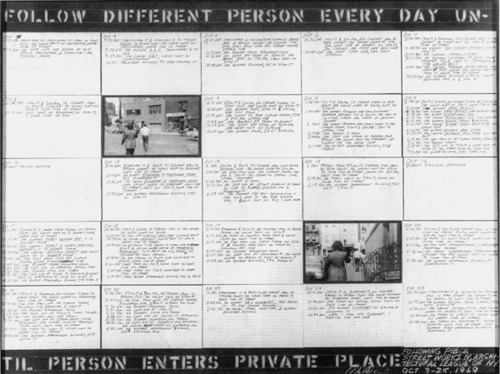
Conceptually, the piece of art dealt with public vs. private, the human body, and how one can subject him or herself to uncontrolled factors through the human body, in essence, making the following of strangers performance, creating a subjective and subjunctive relationship, subjecting oneself to another while being contingent.
I was drawn to this artwork, and having never done anything like this myself, decided to try it. Following his framework, or controlled factors for the experiment, first I needed to follow a person. Second, I needed to add myself to another person giving up control. Third, I needed to follow that person throughout public space, no matter how long, until that person entered a private space. Acconci describes some of his following episodes taking seven to eight hours or as short as two to three minutes.

April 2, 2013
11:34AM
woman with dyed blonde, curly hair in black puffer jacket & boy in black, both holding Target plastic bags, heading East on Witherspoon St on North side; initially spotted at Spring St intersection with Witherspoon St
11:36AM
turn right onto Nassau St; heading South on West side of street
11:39AM
cross left at University Pl intersection; head across intersection median & head down Mercer St South on East side of street
11:41AM
jaywalk across Mercer St to West side of street
11:42AM
enter Trinity Episcopal Church site grounds
11:47AM
spotted sitting together on bench outside of church
11:51AM
group of toddlers and daycare providers from morning daycare at Trinity Episcopal Church arrive to bench I am sitting on in front of church site entry doors; woman & boy get up from bench they are sitting on at rear entry of church; woman now has stroller and greets daycare providers and puts toddler in stroller that is part of the group sitting on the nech I was sitting on; woman, child & toddler in stroller head back towards Mercer St around rear of church
11:55AM
walking back up Mercer St North on West side of street
11:56AM
jaywalk on Mercer St to East side; jaywalk again across intersection median to walk North on Nassau St on East side of street
11:58AM
stop in front of Nassau Presbyterian Church briefly
12:02PM
cross Nassau St onto Witherspoon St; walk West on North side of Witherspoon St
12:05PM
walk into Princeton Public Library at East piazza entrance
12:15PM
spotted sitting inside Terra Libri Cafe inside library
12:28PM
boy enters elevator alone past library entryway
12:36PM
woman pushing stroller & toddler out of stroller enter into elevator
1:49PM
spotted on first floor of library in rental movies sections near entryway
1:55PM
head West on Witherspoon St on North side; cross Wiggins St
2:07PM
turn right onto residential street at Guyot Ave or just past
Image source. Acconci, Vito. Following Piece. 1969. Museum of Modern Art. New York: 2013. Apr 2 2013 <http://www.moma.org/collection/object.php?object_id=148165>
Content source. McMahon, Jp. "Vito Acconci's Following Piece." Khan Academy. 2013. Apr 2 2013 <http://smarthistory.khanacademy.org/conceptual-artacconcis-following-piece.html>
1 note
·
View note
Text
From Tsunami to Storm Surge
Case studies from disaster relief projects N˚01
How does design play a role in preventing sites devastated by natural disaster from becoming sites of decline?
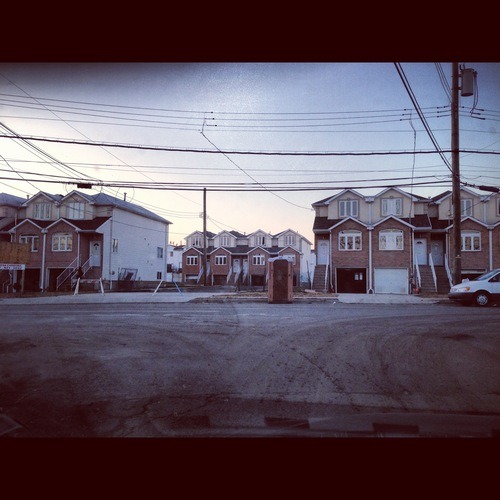
As a disaster relief volunteer on site in Northeastern Japan following the Great East Tsunami, and now in Staten Island after Superstorm Sandy, I was witness to the destruction displaced water can have on the physical and built environments. Rising sea levels due to climate change are projected to have greater affect on these shorelines zoned for flooding.
Contrary to belief, there is opportunity to be found in the wake of disaster. Relief efforts are sites of collaborative effort that offer opportunity for design to be an agent in rebuilding efforts. At these moments, where new landscapes of destitute have formed, applied research and civic engagement for a smarter and sustained future use of these sites must manifest into built form.
On March 11, 2011, a level 9.03 earthquake shook off the coast of Northeastern Japan creating one of the largest tsunami waves to ever hit Japanese soil. It swept into and took with it hundreds of miles of coastline, flattening cities and towns in its path.
Disaster relief organizations come in post-disaster to give support to effected communities. I volunteered with a non-profit, disaster relief organization All Hands Volunteers(AHV), one that services international and domestic(American) projects for all types of natural disasters. The organization drives itself on the basis that those devastated in these communities have a found prerogative for help from others, and that is where their support and motives come from.
AHV provides support to effected communities in various forms, one through the remediation of the built environment. The typical process starts by assessing a property of its damage to provide the necessary steps to be taken either by general skilled or specialized volunteers.(1) Operations may include de-mudding, clearing or removal of debris, gutting and demolition.
Rebuilding, the next step, is where there is great opportunity for design ideas to be realized in current and on-going projects. AHV has created several project-specific programs for different rebuilding methods, and has collaborated with organizations such as regionalized Habitat for Humanity groups. Typically, AHV prepares a damaged structure to a state where it can be rebuilt. In doing so, the property owner may take over the rebuilding effort, or an outside organization in collaboration with AHV will take place.
On Project Tohoku, AHV's response to the Great East Tsunami in the Tohoku Prefecture of Japan, several programs were designed to fit the rebuilding needs of the communities devastated along the Northeastern coastline where the organization was based.
The organization employs general skilled volunteers for many tasks including construction and demolition practices providing a simple and zero cost service to those effected. One program I worked on offered the removal of soiled sub-floor and wall insulation and installation of new insulation and floor boards.
On the same project, AHV collaborated with local artists to colorfully paint buildings in devastated areas of the community. The image below in an example of a design of a mural painted by local Japanese artist, Kensuke Miyazaki, with the assistance of volunteers, on all four walls and the rooftop of a reclaimed barber shop that sits in the city's devastated center(2). The design of the artwork brings a certain life back to the community.
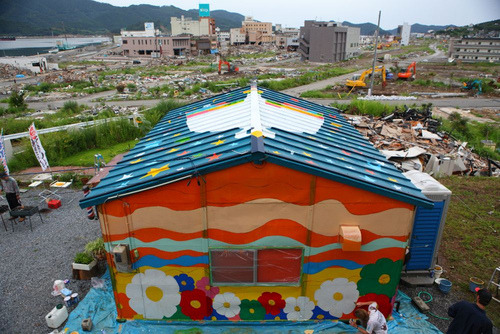
Collaboration of AHV with Habitat for Humanity has resulted in successful reconstruction of communities. Where AHV is responsible for preparing a devastated site for new construction through clearing, gutting, and/or demolition, Habitat for Humanity introduces a new project-specific prototype to be built and duplicated on site.
A current example of this collaboration's success is on Project Cagayan de Oro, a response to Typhoon Sendong in the Phillipines. Simple design and planning techniques were used to construct low-cost, multi-family houses for those displaced. In addition, AHV established a Tree Planting Program to landscape the sites alongside the construction of the prototypes. Volunteer Edyta Materka explains that the Tree Planting Program "allows residents to pick and choose the development trajectory of their communities. (It) promoted a community engagement in planting and growing trees. AHV has enabled the transformation of a relocation site of 800 new families into a community," (3).
There is opportunity for design ideas to manifest themselves in rebuilding efforts by latching onto the relief efforts of these project types, through partnership and collaboration. Organizations like AHV provide a backbone for designing a better future.
Sites, like Staten Island, a project to be affected by rising sea levels. How do we, as designers, challenge existing conditions to rebuild for a smarter future? Will what exists withstand the test of another storm surge? By using the tools readily available, we can implement applied research and smarter design in current rebuilding efforts.
(1) AHV on projects accepts general skilled volunteers who need no previous experience in general labor practices for certain projects. Where there is need, they call for volunteers of skilled labor (electricians, carpenters, contractors, etc.). Currently, on the response projects to Superstorm Sandy, with locations in Staten Island and Long Beach, NY, a mold remediation program is underway after a couple of months of de-mudding, gutting, and demolition efforts. Volunteers are currently training to gain specialized skill-sets for working in the field as well as to better team lead and train general skilled volunteers. http://hands.org
(2) Painting a Barber Shop. (2011). [photograph]. Retrieved from: http://hands.org/2011/11/02/softer-side-of-all-hands/
(3) Materka, Edyta. "Transforming a Relocation Site into a Community". AHV. 31 Oct 2012. Web. 05 Jan 2013.
#NYC#Staten Island#All Hands Volunteers#Habitat for Humanity#Project Tohoku#Project Staten Island#Superstorm Sandy#Great East Tsunami#design#architecture#urban design#volunteer#disaster relief#non profit#NPO#climate change
3 notes
·
View notes
Text
Square photography favorites: Urban iPhoneography
At a size of 3264 x 2448, 8 megapixels, and square in composition, the following artists use their iPhones and Instagram to capture stills in the cities where they live. These cities happen to be my three favorite, New York, Florence, and Berlin, with Timothy Schenck, Kevin Angel, and Michael Schulz, respectively, documenting each, with the help of filters.
I have a new found obsession with their work that I would like to share because I believe there is a lot of talent there. Feel free to check them out on Instagram via their handles cited below.
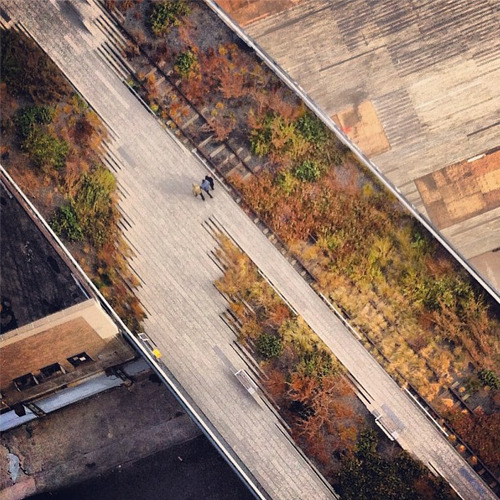
A couple of @highline ants, @timothyschenck
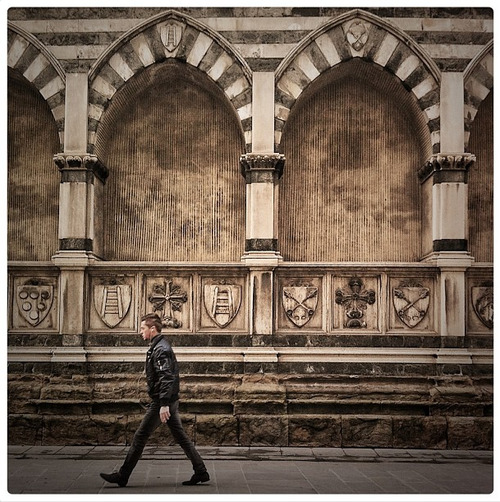
Lo stile di Firenze N°006, @_kevinangel_

#berlin, @berlinstagram
Kevin Angel is an iPhone photographer who predominately takes pictures of Florence, Italy. In addition, he takes pictures of his travels and uses a young girl, assuming his daughter, as the subject of some of his photographs.
Michael Shulz is a concept designer in Berlin, Germany while working on Berlinstagram, a private iPhoneography project on the city of Berlin. His work has been featured on the official Instagram blog as well as Berliner Morganpost Newspaper.
#photography#NYC#Florence#Firenze#Berlin#highline#Santa Maria Novella#Timothy Schenck#Kevin Angel#Michael Schulz#iPhoneography#iPhone#Instagram#urban
1 note
·
View note
Text
There’s Something About Gehry
Review of Conversations with Frank Gehry by Barbara Isenberg
Through school, I struggled to understand both the work of Frank Gehry and the mild bastardizing of his work in discourse. While I didn’t understand his design or the ideas behind them, I realized I never tried. But after having traveled to Europe, and stumbling upon some of his work, I then realized I had to because I found there is something more to Gehry than meets the spoken word.
It is ironic that I had to travel to Europe to better appreciate the work of an American architect. However, having grown up in the New York metro area, where in the city the In-N-Out burger was vetoed and the Shack Burger reigns, the work of the infamous architect from the West did not prosper.
After reading Conversations with Frank Gehry, his design became more clear. In his creative process, he designs objects and then the space between, in turn building little cities. Forget not, he studied city planning at Harvard. He quotes Phillip Johnson as saying one-room buildings are the best buildings in history, noting Chartes Cathedral, the Pantheon, Le Corbusier’s Ronchamp(5). In essence, he designs villages of one-room buildings where “the architecture is the play between spaces,” (6).
Gehry notes two of his favorite works of architecture, one being Ronchamp, and the other Alvar Aalto’s Town Hall in Saynatsalo, Finland(Figure 1). Gehry’s designs do not set importance on frontality, an example being a front facade of a Renaissance cathedral. Rather, they take on a more wholistic approach to facade and object.

1
The first Gehry building I saw was the Dancing House or Nationale-Nederlanded Building in Prague. In school, I had learned about its context taking from the facades of the buildings along the river and the river itself. I was surprised to learn that he created the waist for the ‘Ginger Tower’, the contoured one on the corner, to permit better views for people in existing fabric, who would otherwise not get them in a more conventional, allowable building mass on the site(79). I remember a fellow student I was traveling with, at the time, wouldn’t go to see the building with me, only being a few blocks away from our hostel. I didn’t quite understand her disgust for his work because once I got there, I was quite struck by how immediately I enjoyed its contextualism and flirtatious contours of the tower. I do think it was quite a brave design move that works, taking an avant-garde idea and having it dance with its context. Gehry makes a good point, though, of American thought versus European thought. While Americans may be more susceptible to change and to experiment, design and architecture may be given more value in Europe because of its history(80).
A few of his projects I am now more interested to see and experience in my future travels include the Walt Disney Hall in LA(Figure 2), the Guggnenheim Bilbao(Figure 3), the Issey Miyake Store in New York(Figure 4), the Stata Center at MIT(Figure 5), and the Richard B. Fisher Center for Performing Arts at Bard College in Annadale-on-Hudson(Figure 6).
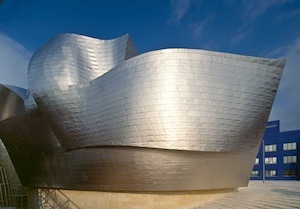
3

4
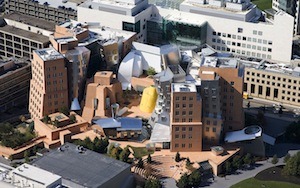
5
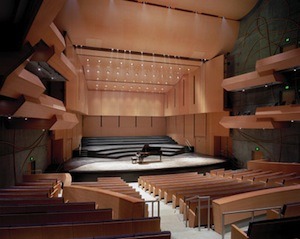
6
At the Stata Center at MIT he uses a difference in materials to break down the scale at an urban level of the large scale project. At the Guggenheim Bilbao, I learned how he brought down the building user from street level to the level of the river to enter in and circulate around the museum’s center(Figure 7). I also enjoyed one of his unrealized projects for the expansion of the Corcoran Gallery of Art in DC for his use of contextualism(243). Being so completely different to its surroundings, it quite respected them(Figure 8).
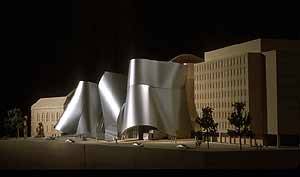
8
When designing, the idea or the answer comes intuitively from his drawing and sketching, like when a sculptor carves out of stone to produce the answer, “The building has to be designed from the inside out, and whatever the program is, it has to work, and you can’t know all of that in the first sketch,” (92). He takes pride in that aspect of design relating the process to that of sculpture. Princeton scholar Irving Lavin called him Bernini, and in his book’s closing, he accepted that name, or rather that honor.
Those who are more pluralistic thinkers may be more open-minded or accepting of Gehry’s work. While I do not like everything he and his team have turned out, I have a much greater appreciation for his work now that I have come to understand it better.
Isenberg, Barbara. Conversations with Frank Gehry. Alred A. Knopf, New York: 2009.
#Gehry#library#NYC#travels#Aalto#Corbusier#Prague#LA#Bilbao#New York#Boston#city planning#urban planning#urban design#Johnson#context#sketch#Bernini
1 note
·
View note
Text
Film: Battle for Brooklyn(2011)
Great place-making sometimes comes from the removal of other place(s).
The film Battle for Brooklyn(2011) documents the fight a community in the borough of Brooklyn faced, starting in 2003, as their homes and business were being taken by eminent domain, in order to build a real estate development project, which has come to fruition today as the Barclays Center, home of the Brooklyn Nets.
My support for the film's themes are crossed as I am in support of the arguments against the abuse of eminent domain and for community development. At the same time, I also support the building of the Brooklyn Nets stadium and subsequent urban housing projects.
Removal and destruction of complete neighborhoods are often opposed. Eminent domain, according to the Merriam-Webster Dictionary, is a right of a government to take private property for public use by virtue of the superior dominion of the sovereign power over all lands within its jurisdiction. In New York City, and the area of Brooklyn where this took place, private property has to be deemed blighted or unhealthy and unsanitary conditions in which to live. The film expressed that this area was not blighted, and only designated so after the beginning of the project's process.
One of the community's groups against eminent domain abuse used the slogan Develop--Don't Destroy. Brooklyn. Through the efforts of the community, other solutions were offered to the city and the developers for less invasive ways on the physical environs to introduce a new sports arena and housing. One example offered building the bulk of the arena over the existing MTA tracks and bifurcating a street in order to maintain one of the blocks from being demolished.
Do you excise city block(s) that are people's homes and businesses, a place of community, in order to build a new place to be enjoyed by a greater community? Take Grand Central Terminal, for example. Huge building and infrastructure projects, like a transportation hub, wipe out acres of a city in order to be build. These projects are immensely invasive, displacing thousands, and obliterating communities. However, in the case of Grand Central, there is a great return economically, culturally, as a landmark, as a generator of the city, its inhabitants, etc.
So does that hold true at the Atlantic Yards development? The Atlantic Yards proposal may be flawed, but I do not think the realized Barclays Center and housing projects, that recently broke ground on site, are the issues of the development. I would have to agree with a theme from the film that overhaul plans that wipe out portions of a city seem ludacris. However, projects like the Barclays Center, Grand Central Terminal, Rockefeller Center (mentioned in the film), and so many others, have used eminent domain to create places in the city for the greater city. While I may not agree with the abusive use and unjust nature of property seizure at the Atlantic Yards development, a scheme, I believe, to be a flawed and over-developed one, I will support the advantages of the Barclays Center to the greater community and to Brooklyn.
#PEFF#Battle for Brooklyn#Brooklyn#NYC#eminent domain#Barclays Center#urban housing#Brooklyn Nets#urban planning#Atlantic Yards
0 notes
Text
Influence: Art Deco

My boss has a large library in the office that seems disorderly and outdated. Yet I found there's a certain order to the disorder and a wealth of knowledge and wisdom on the shelves. And in discovering this, I found his section dedicated to art deco.
These images below are from a little gem I found in the stacks entitled The Art Deco Style: Household Objects, Architecture, Sculpture, Graphics, Jewelry with 468 "authentic examples" selected by Theodore Menten. It was printed in black and white and published in 1972...
The art deco style shows how geometric design can be absolutely beautiful.
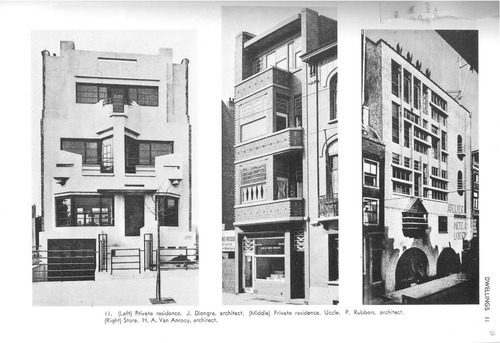
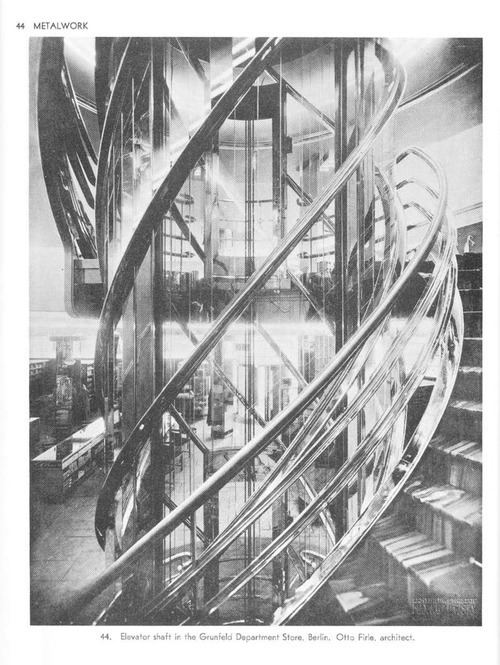
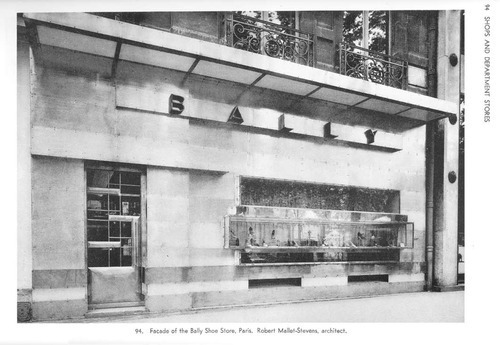
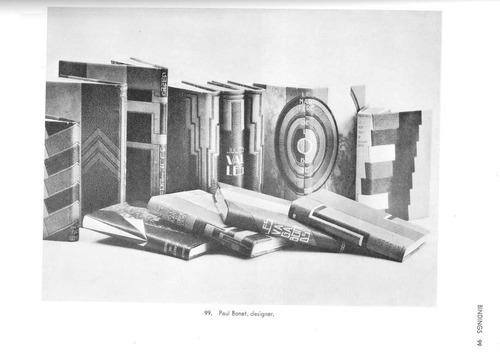
#artdeco#library#metalwork#metal#diongre#rubbers#facade#housing#urban residential#van anrooy#urban housing#elevator#retail#berlin#firle#book binding#bonet#windows#subes#paris#mallet-stevens#doors#legrain#menten
3 notes
·
View notes
Text
Inspiration Boards
Here are links to my inspiration boards. One focuses on architecture and design while the other focuses on urban fashion.
Image above, pinned on one of my inspiration boards, is of the LVMH Tower near the Northeast corner of Central Park in Manhattan. Designed by Jean Nouvel.
Image below, also pinned, is a Vogue Photoshoot of Marion Cotillard shot by Peter Lindberg.
0 notes
Text
Inspiration: New York City
I recently graduated from architecture school last May and found months later, after joining the workforce and jumping into the real world, I had this longing to be academic. I had this desire to research, write and discover, just as I had in school. While I am enjoying working as a professional, I chose to dip my toes into the blogging world to satisfy my cravings.
Cities are where I feel at home and where much of my inspiration comes from. I have lived in a city stuck in the Italian Renaissance, a port city in Northeastern Japan devastated by a tsunami and an American post-industrial city victim to lake-effect snow. But it is New York City, Manhattan, its boroughs, that I've fallen in love with.
I lived in the East Village of Manhattan for a semester and found so much inspiration, that I decided to base my architectural thesis project on my experiences living there. Now having completed thesis and having moved to Princeton, NJ for a job, I hope to continue my love affair with the city as its mistress, only a 60 minute express train ride away.
I hope to share any insight on design that relates to my interests and experiences as an architectural designer and disaster relief volunteer. My architectural interests include those I explored in my thesis project, low-rise vs. high-rise, density, urban housing, urban public spaces focusing on relationships such as sidewalks to facades to interior spaces to property lines, etc. Please feel free to question, start or add to the conversation.
Image Source: "Gaga Over a Gargoyle". Annie Liebovitz. Smithsonian Magazine. 1991.
0 notes